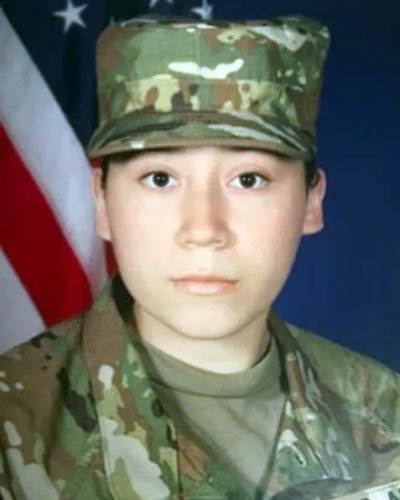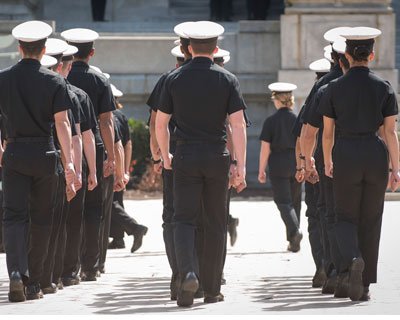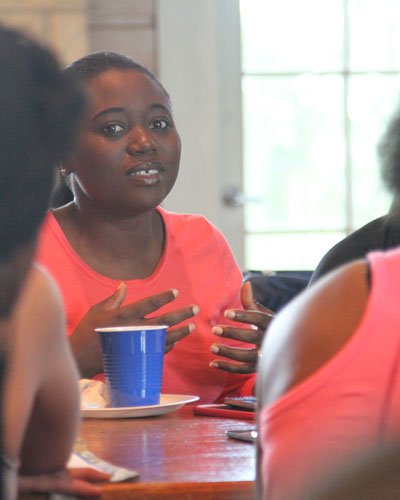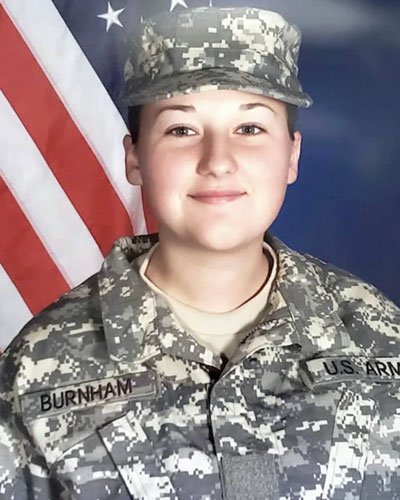Short Changed: Military Women’s Deaths by Suicide Linked to Sexual Trauma
This article is part of Short Changed, a series looking at the noncombat deaths of women going back to 9/11.
As of Jan. 17, veterans thinking about hurting themselves can get free crisis care, including inpatient, for up to 90 days at Veterans Affairs. They do not need to be enrolled in VA care. For immediate help, dial 988, then press 1.
As Spc. Mikayla Bragg’s deployment to Afghanistan was coming to an end in 2011, she bought a plane ticket home to surprise her mother. She knew her mom liked a television show that featured military members coming home from deployment to surprise their families, so she hatched a plan to show up unannounced at her sister’s basketball game.
But Bragg didn’t make it home. A week before she was set to fly back to the United States, she was shot while she stood watch alone in a guard tower. Her last radio check had been about 10 minutes after she assumed watch. A little more than three hours later, when a fellow soldier brought her some lunch, rigor mortis had started to set in.

Army officials say Specialist Mikayla Bragg killed herself while alone on duty in a guard tower. She had told friends a civilian contractor raped her. Photo courtesy of the U.S. Army.
Bragg had joined the military two years earlier, looking for a decent job and a way to pay for school.
“She would always be the first to volunteer in everything. She had made a lot of friends,” Bragg’s mother, Sheyanne Baker, told The War Horse in a 2021 interview. “She always tried to make people around her laugh.”
In its investigation into her death, the Army determined Bragg shot herself. Soldiers interviewed during the investigation said repeatedly that they hadn’t seen anything to indicate Bragg might kill herself—she always seemed upbeat. But Bragg had tried to kill herself before, during earlier training at Fort Knox, Kentucky. In fact, concerns over her mental health had prevented her from deploying to Afghanistan with her unit.
But Bragg wanted to serve with her fellow soldiers. She weaned herself off the anti-anxiety medication she took and joined her unit late. Nobody told her commanders in Afghanistan about her mental health struggles or her previous suicide attempt, according to the Army’s investigation into her death.
“We call it murder by suicide,” Braley Franck says. “They are preventable deaths.”
Then, while she was deployed, a civilian contractor sexually assaulted her, she told friends.
Bragg joined a long list of women who signed up to serve their country but died—not in the line of fire, but rather by fatally injuring themselves, often following sexual assault, harassment, or a toxic command climate.
The military has long struggled with the twin plagues of suicide and sexual assault, but it rarely explicitly ties the two together. While men in the military also have alarmingly high rates of death by suicide, the deaths among military women are increasing at a faster rate, and their experiences of military culture—and the reasons they kill themselves—differ from men’s.
Over the past three decades, the Defense Department and the military branches have implemented training programs, support groups, hotlines, and leadership councils dedicated to tackling both the issues of suicide and sexual assault. But sustained successes have proven elusive, and few resources are devoted to studying how the two issues are connected.
In 2018, then-Secretary of Defense Gen. James Mattis alluded to suicides following sexual assault in a department-wide memo on sexual assault awareness and prevention. “While casualties on the battlefield are understood to be consistent with our military duties, I accept no casualties due to sexual assault within our ranks,” he wrote.
Yet such casualties have made headlines again and again—before Mattis’s declaration and after:
- Amy Duerksen, who wrote in her diary about being raped and how her chain of command berated her when she reported abuse, before killing herself in 2006
- Sophie Champoux, who killed herself in 2011 after she told her mother she was raped multiple times while serving in the Army
- Kaylie Harris, who was sexually assaulted 10 days after coming out as gay on Facebook in 2021, according to her mother, and died by suicide three months later
- Nicole Burnham, who killed herself in 2018 after requesting an expedited transfer following sexual assault—but instead was kept on base, in the same barracks as her assailant
“If you would have looked at that girl one time and saw her losing weight, [saw] her hair falling out—if one leader would have talked to her and asked her a question—but nobody did their job,” says Amy Braley Franck, a victim advocate who has worked with Burnham’s family and who was removed from her job as an Army victim advocate after raising concerns about widespread mishandling of sexual assault cases in the Army reserves in 2019.
“We call it murder by suicide,” Braley Franck says. “They are preventable deaths.”
‘She Got a Living Hell’
Sgt. Amanda Sheldon was raped by a superior in the Army. Sheldon reported the assault, and the rapist was discharged from the Army and convicted. Sheldon saw a therapist regularly. But her mother told a local reporter that when Sheldon was up for a promotion, her leadership asked her why she was receiving mental health care. Eventually, her mother said, Sheldon stopped seeing the therapist. Later, as she struggled over whether to reenlist and deploy to Afghanistan, Sheldon refused to see a counselor. She killed herself in 2010.
Award-Winning Journalism in Your Inbox
In 2016, Spc. Morgan Robinson reported sexual assault by a superior while she was deployed to Kuwait, but she received no support, her mother told CBS News. Later, she was sent to Afghanistan, where her mother said she was gang-raped by multiple soldiers. Robinson killed herself in 2018. In the investigation into her death, the investigating officer wrote that Robinson had “suffered sexual, physical, and psychological trauma while deployed. The sequela of this trauma was a factor in her death.”
In 2018, Airman 1st Class Sissy Cox died by suicide after being sexually assaulted multiple times. A superior raped Cox while she was stationed at Wright-Patterson Air Force Base, Ohio, and she reported the assault. Afterward, the Air Force transferred her to Joint Base San Antonio, Texas, so she could be closer to her family as she recovered. But while she was there, she was sexually assaulted again, this time by a military contractor—a certified nursing assistant who worked in the mental health department.
“She got a living hell when she joined the Air Force,” her father told Fox San Antonio, Texas.
Just this spring, Pvt. Ana Basaldua Ruiz died by suicide after telling her mother that she was being sexually harassed at Fort Cavazos. Fort Cavazos was formerly known as Fort Hood, where Vanessa Guillén was murdered in 2020 by a fellow soldier after telling her mother she was too afraid to report sexual harassment. Army and base leadership promised to do better following Guillén’s disappearance and death.

Pvt. Ana Basaldua Ruiz killed herself after telling her mother she was being sexually harassed and telling friends and family she had been physically assaulted by a partner. Photo courtesy of the U.S. Army.
“She told me, ‘Mom, everyone wants me to sleep with them,’” Basaldua’s mother told Telemundo after her daughter’s death.
These deaths are set against a cultural backdrop that still struggles to fully incorporate women, despite repeated promises that the military is becoming, in the words of the 2021 Interim National Security Strategic Guidance, “a place of truly equal opportunity.”
In January 2013, then-Secretary of Defense Leon Panetta removed the military’s long-standing ban on women soldiers serving in combat. While women have served in U.S. combat roles since the Revolutionary War—when Deborah Sampson and Margaret Corbin fought the British forces—more often, women’s work in war has been relegated to supporting roles. In 1994, the Pentagon had officially banned women from combat positions.
But in reality, these “supporting” positions were often effectively combat roles, particularly during the recent wars in Iraq and Afghanistan, when women guarded convoys, when their military police units filled in for infantry units on patrol, and when they served as medics and interpreters for Special Operations units.
“There’s always an asterisk,” says Kinsey Spears, a researcher who recently completed a doctoral degree focused on gender and security. “It denigrates their very, very real combat experience.”
Because their service wasn’t recognized as such, women have received fewer awards and promotions, contributing to the relative dearth of women in senior leadership positions.
Panetta’s pronouncement did away with this pretense, paving the way, for the first time, for women’s full integration into the military. In 2016, Defense Secretary Ash Carter officially opened all military roles in all branches to women.
The Army minted its first female Green Beret in 2020; the first female Air Force commando graduated in 2022. But the Navy has yet to have a female SEAL, and reporting by Task and Purpose on an internal U.S. Army Special Operations Command report revealed that 40% of women in Army special operations in 2021 said they faced gender discrimination, pointing out that equipment didn’t fit their bodies and that sexual harassment remained a problem. Male soldiers also struggled with integration. “Stop the social experiment,” one senior male noncommissioned officer said.
In the summer of 2022, Maj. Gen. Patrick Donahoe, the former commanding officer of the Maneuver Center of Excellence at Fort Moore—then called Fort Benning—in Georgia, was investigated and found to have brought “negative publicity” on the Army for publicly defending women soldiers after Tucker Carlson told his viewers that developments like flight suits for pregnant aviators were “making a mockery of the U.S. military.”
“People don’t look at female servicemembers and think that, ‘That’s value added,’” says Lindsey Knapp, a victim advocate who, like Braley Franck, was removed from her job with the U.S. Army’s Special Operations Command in 2018 after raising concerns about the way the Army handled the case of a Special Forces soldier accused of rape.
“Women are something that is tolerated in the service.”
‘There May Be Not Enough Women for that Social Connection’
In the 12 years since Mikayla Bragg died alone in a guard tower in Afghanistan, death-by-suicide rates among military members have only increased. In 2011, when Bragg died, the rate among active-duty members was 18 per 100,000 active-duty service members. In 2022, the most recent year for which data is available, it was 25 per 100,000, though it climbed as high as 29 in 2020. Research from Brown University’s Costs of War project found that in the two decades following 9/11, more than four times as many active-duty members and veterans killed themselves than died in overseas wars.
Self-inflicted death was the largest category by far of death in the military in 2022, according to the Defense Casualty Analysis System. The problem is particularly acute for women. The data on categories of military deaths is not broken down by gender, nor does it specify “suicide.” But in the United States broadly, suicide is the third leading cause of death among women ages 20 to 34, according to the Centers for Disease Control. An analysis conducted last year by the Voice of San Diego found that women in the military between the ages of 17 and 30 are more than twice as likely as their civilian counterparts to die by suicide. Another analysis by The Hill found a similar statistic.

Sgt. Sophie Champoux killed herself after she told her mother she had been raped several times while serving in the U.S. Army. Photo courtesy of the U.S. Army.
Deaths by suicide among civilian women are also increasing, making understanding the complex factors affecting military women and suicide difficult, says Rajeev Ramchand, co-director of the RAND Epstein Family Veterans Policy Research Institute, who has studied suicide in the military community.
“There’s so many questions inherent in that,” Ramchand says. “How do you disentangle the military-woman effect versus the woman effect versus the military effect?”
Researchers talk about a “gender paradox” in suicide: Women think about and attempt suicide more than men—but they also are more likely to survive a suicide attempt. That may be because women tend to use methods that aren’t as likely to immediately kill them, like pills. Men are more likely to use guns.
In the military, that calculus can change. “[T]hey have firearms, and they’re more likely to attempt with a firearm, then they’re more likely to die as a result of their attempt,” Ramchand says of military women.
The morning Bragg died, an Afghan soldier had also been posted in the same guard tower. But according to statements in the investigation into her death, soldiers received guidance that Afghan soldiers shouldn’t stay in guard towers with women soldiers, so he left. Bragg was alone with a 12-pack of water and an M4.
Women make up a minority of active-duty service members—just over 17% in 2021. Rebecca Blais, an associate professor at Arizona State University who studies sexual assault and suicide in the military, says that while women in uniform experience many of the same suicide risk factors their male counterparts do—among them relationship and financial stressors—feeling alone can add additional stress.
“With women—and men who in some ways are not part of the majority, so maybe they identify as gay or nonconforming—their social circles are usually much smaller to begin with,” Blais says. “And so you’ve got someone who might already be feeling pretty isolated. … You get these folks who have small support networks.”

Midshipmen march to lunch at the U.S. Naval Academy during the National Discussion on Sexual Assault and Sexual Harassment at America’s Colleges, Universities, and Service Academies in 2019. Photo by Mass Communication Specialist 1st Class Sarah Villegas, courtesy of the U.S. Navy.
In May, the U.S. surgeon general, Vivek Murthy, released an advisory warning that loneliness and a lack of social connection were fueling a mental health crisis in the country. “People began to tell me they felt isolated, invisible, and insignificant,” he wrote. “Loneliness and isolation represent profound threats to our health and well-being.”
Loneliness can be even worse for women in the military.
“In any particular unit, there may be not enough women for that social connection,” says Melissa Dichter, an associate professor at Temple University who has studied the health needs of women veterans.
“[T]hat opportunity for gender, social support, and mentoring and connection is more limited. And we know that historically, the military has been very male-dominated and at times hostile or unwelcoming to women.”
‘This Problem Is Deadly’
About two months before Mikayla Bragg died, according to the investigation into her death, Bragg told friends she’d gone to the room of a civilian contractor. She said she passed out on the floor after drinking, and when she woke up, the contractor was sexually assaulting her. She’d also been raped before she entered the military, she told fellow soldiers.
Some estimates suggest that as many as a quarter of all military women are sexually assaulted during the course of their service. Blais has found that people who experience sexual trauma in the military may be more likely to consider suicide than those who experience combat-related trauma.
“What we found is that when individuals reported that the most traumatic military event for them was [military sexual trauma], they were about three times more likely to experience suicidal ideation relative to someone who experienced combat as their most traumatic event,” she says.
The Department of Veterans Affairs also points to military sexual trauma as a specific suicide risk factor among both men and women—though women are more likely to experience sexual trauma during their service.

Capt. Stephanie Okolo, the chaplain for the Regimental Engineer Squadron, 3rd Cavalry Regiment, shares tools to combat death by suicide with a group of women soldiers during a “bonding with the squadron commander event” at Peaceable Kingdom in Killeen, Texas, in 2016. Okolo said she thought of the idea for this event after several soldiers approached her about wanting to talk to the squadron commander outside the regular work environment. Photo by Staff Sgt. Tomora Clark, courtesy of the U.S. Army.
The military has tried for years to end sexual violence in uniform. Since 2010, there have been more than 200 recommendations from government panels and task forces, more than 50 initiatives from the Secretary of Defense, and more than 150 congressional requirements, all aimed at stemming the problem.
In 2021, at the direction of President Joe Biden, Defense Secretary Lloyd Austin announced an independent review commission to study the reasons for the epidemic of sexual assault in the military and offer recommendations on how to fix the problem.
In interviews with the commission, women who were assaulted reported feeling overwhelmed and said they were offered little or no support as they sought assistance and accountability through the military justice and health systems. Most women regretted reporting their sexual assault, and the authors noted that multiple women they had spoken with thought about or attempted suicide after seeking help for sexual assault.
“This problem is more than serious, it is deadly,” they wrote.
But military reports on suicide have historically not addressed sexual violence. In recent years, that has been changing, though slowly and unevenly.
A 2010 Defense Department task force on suicide prevention report makes no mention of sexual assault, harassment, or even gender.
The Defense Department’s 2015 Strategy for Suicide Prevention mentions sexual assault only in its appendix glossary, as an example of a traumatic event in its definition of post-traumatic stress disorder. It does not mention harassment.
An independent review commission on suicide in the military, which released its report last year, ensured that it included experts in sexual assault response and prevention, and its report pointed out that sexual harassment was one of the top risk factors for attempting suicide at the bases it visited. But while its 127 recommendations include ideas aimed at improving leadership culture and increasing access to mental health care, the only explicit mentions of sexual assault or harassment are one recommendation to incorporate conversations around alcohol use in existing sexual harassment and assault prevention training, and another around organizing force resiliency offices, including the defense department’s sexual assault prevention and response office.
In 2021, for the first time since 2017, the military’s annual report on suicide in the ranks included some data on sexual harassment, finding that just over 5% of servicemembers who attempted suicide that year reported being sexually harassed the prior year. In 2022, the annual report also included data on sexual assault—7.4% of servicemembers who attempted suicide reported being sexually assaulted. But both sexual harassment and assault is notoriously underreported in the military, and data is not provided for actual suicides.
And despite the military’s repeated promises to end sexual violence in uniform, the parade of panels, task forces, and recommendations has achieved little, statistically. Reports of sexual assault are increasing, and prosecutions of perpetrators are declining. Last year, reporting by ProPublica and The Texas Tribune found that in the Army, soldiers accused of sexual assault are less likely to be confined than those accused of drug offenses or disobeying a senior officer.
“We keep spending money, doing investigations, doing Senate hearings, doing all of these things. And there’s no follow up,” Braley Franck says. “I feel like wash, rinse, repeat.”
‘One-Size-Fits-All Will Not Be Effective’
The military as an institution is predicated on uniformity—troops go through the same basic training, wear the same uniform, sport the same hairstyle. The idea is that being forged in the same fire helps create unbreakable bonds.
Spears points to the concept of “battle buddies”—the idea that troops are expected to help their comrades-in-uniform, on and off the battlefield. “These things are long-standing military traditions because they help keep people safe and sane when they’re deployed,” she says.
But women’s experiences in the military can be fundamentally different from men’s.
“By not incorporating women into that [mentality], and by not making them feel like they are equal parts of the team—because they’re being sexually harassed, because they’re listening to men talk about other women in a way that makes them feel less than, even if it’s not directed at them—all affects an individual’s ability to bond with and rely on their unit,” Spears says.
“[W]e think of military culture as a little bit more focused on group cohesion. … Gender isn’t necessarily always incorporated into discussions around group cohesion.”
But researchers say that incorporating gender into meeting mental health needs is critical.

Pvt. Nicole Burnham killed herself after asking to be moved away from her assailant after reporting a rape. Instead, she was kept in the same barracks. Photo courtesy of the U.S. Army.
“We don’t just live in our heads, but we also live in society,” Dichter says. “We know that people are affected by societal impact by discrimination, by how it works, how we’re treated in public and what our access to resources are. … Gender is part of our social experience that can impact our health and well-being.”
The White House’s 2021 strategy for reducing military and veteran suicide acknowledges this reality, noting the evolution of mental health treatment toward tailored interventions based on the idea of “right time, right treatment, right intensity, right person.”
“One-size-fits-all approaches will not be effective,” the report states.
Among the high-risk groups it highlights whose unique needs must be met are young women veterans and survivors of military sexual trauma.
Researchers like Dichter point to the importance of having women-only spaces available for healing, as well as female responders to crisis situations and female mental health care providers for those who want it. But women who report sexual trauma in the military still struggle to get the resources and time they need to heal, and the military—like much of the country—is facing a severe shortage of mental health care practitioners.
In 2019, eight years after Mikayla Bragg died by suicide, Cpl. Anne Vassas deployed to Japan. In her short time in the Marine Corps, she had tried to report sexual misconduct multiple times—after being forcibly kissed in basic training and then after being assaulted in a barracks room. An investigation later found that investigators who responded to her reports both times insinuated that, although she was reporting as a victim, she could get in trouble for the misconduct, according to the New York Times. The inquiries did not go anywhere.
Award-Winning Journalism in Your Inbox
Although Vassas’s medical records said she suffered depression and anxiety stemming from the assault, she was cleared to go overseas. Vassas’s parents later told reporters she had also been diagnosed with PTS, but by a private health care provider—she had been concerned about talking about her struggles in the military within the military health care system.
“She was worried about the consequences of opening up too much,” her mother told Click On Detroit, a local news outlet.
Six months after she was stationed in Japan, just before her 21st birthday, she took her life.
The War Horse is tracking noncombat deaths of military women. Do you have a case to add to our database? Please contact The War Horse.
This War Horse investigation was written by Sonner Kehrt, edited by Kelly Kennedy, fact-checked by Jess Rohan, and copy-edited by Mitchell Hansen-Dewar. Coral Murphy Del Mar contributed reporting. Abbie Bennett wrote the headlines. Prepublication review was completed by BakerHostetler.






Comments are closed.